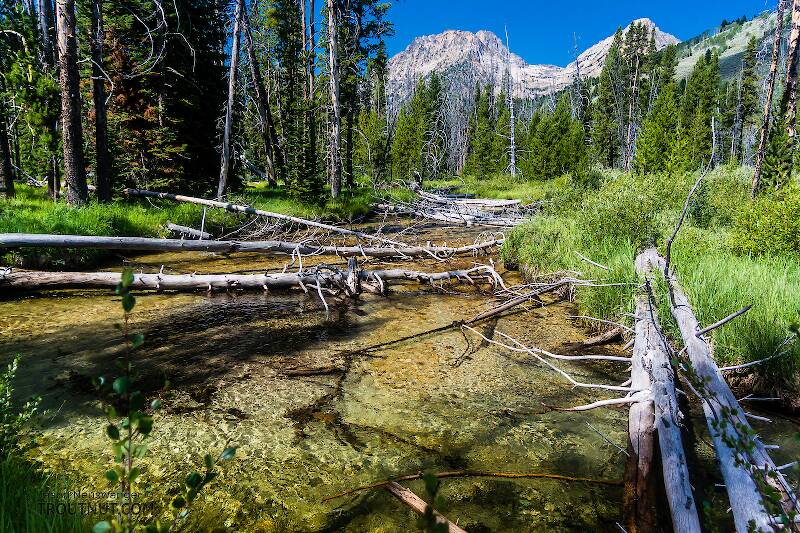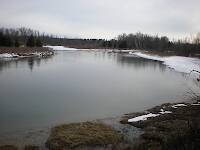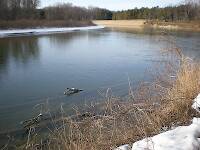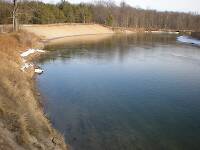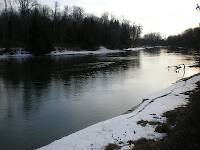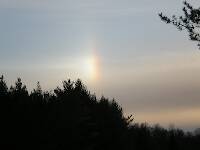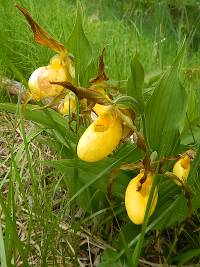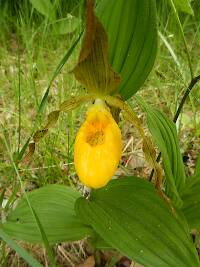
Hex Mayflies
Hexagenia limbata
The famous nocturnal Hex hatch of the Midwest (and a few other lucky locations) stirs to the surface mythically large brown trout that only touch streamers for the rest of the year.
Featured on the forum

This is an interesting one. Following the keys in Merritt R.W., Cummins, K.W., and Berg, M.B. (2019) and Jacobus et al. (2014), it keys clearly to Ephemerella. Jacobus et al provide a key to species, but some of the characteristics are tricky to interpret without illustrations. If I didn't make any mistakes, this one keys to Ephemerella mucronata, which has not previously been reported any closer to here than Montana and Alberta. The main character seems to fit well: "Abdominal terga with prominent, paired, subparallel, spiculate ridges." Several illustrations or descriptions of this holarctic species from the US and Europe seem to match, including the body length, tarsal claws and denticles, labial palp, and gill shapes. These sources include including Richard Allen's original description of this species in North America under the now-defunct name E. moffatae in Allen RK (1977) and the figures in this description of the species in Italy.

Troutnut is a project started in 2003 by salmonid ecologist Jason "Troutnut" Neuswanger to help anglers and
fly tyers unabashedly embrace the entomological side of the sport. Learn more about Troutnut or
support the project for an enhanced experience here.
FrankNale on Jul 8, 2009July 8th, 2009, 6:59 am EDT
I thought you guys might be interested in reading this even though it is not about fly fishing. It is about trout fishing. If not, just delete it or don't read it.
There was a thread on here a several months ago about a guy who had caught 60,000 trout. The link was dead by the time I saw it so I never got to read it. If anyone knows how to find this article, please send it to me at FrankTroutAngler@aol.com. I would greatly appreciate it.
200,000th Trout Caught On Spinners
3:00 a.m. Time to get out of bed. My feet hit the floor within seconds after turning off the buzzing alarm clock. Quickly I dressed, woofed down a big bowl of Honey Nut Cheerios, and loaded my two coolers with enough food, Kool-Aid, and ice to last for two days. By 3:40 a.m. I had my SUV packed, fired up, and pointed north. Ahead of me was more than a 100-mile drive from my residence in northern Blair County, Pennsylvania, to a trout stream in God’s Country -- Potter County, Pennsylvania. The day was June 24, 2009.
I had been looking forward to this day since the prior year, though I didn’t know exactly which day it would be. For over thirty years, since June 3, 1979, I had been carrying on a love affair with spinner fishing for trout. On June 11, 2000, I had caught my 100,000th trout on spinners, and by the time the end of 2008 rolled around, I had meticulously documented catching and releasing 196,551 trout, all from public access streams. Based on data from previous years, I was confident I would catch my 200,000th trout sometime in June 2009. As of the prior day, June 23, I had reached 199,931 trout after a 117-trout outing on Centre County’s Spring Creek and a small mountain brook. I needed just 69 trout to hit the 200,000-trout milestone on this day.
A stack of John Anderson CD’s kept me company during the drive. His country song, “Bend It ‘Til It Breaks,” is my favorite of his work, and when it comes around I always hit the back-one-song button on the CD player a few times. Shortly into the drive, around 4:15 a.m., the sky started to brighten in the east and the stars slowly began to fade. I knew I’d be starting to fish well after dawn, something that is very unusual for me, but since it was a Wednesday in late June, I didn’t think there was a high probability of someone else fishing where I was headed. I’ve known for many years that fishing behind another angler is very unproductive, particularly on wild trout streams, and I typically avoid that at all cost.
Once I got into Clinton County the day began to unfold and I started to see a deer here and there. On one occasion I had to hit the brakes when a doe and spotted fawn walked leisurely across the highway in front of me and into the mown yard of a camp. Another time, at a sharp curve, a hen wild turkey scurried from right to left across the road. I nearly stopped, thinking some poults would emerge from the tall grass and follow the hen, but none appeared.
Around 6:15 a.m. I eased my vehicle off to the side of the State Forest road paralleling the distant stream. I was surprised how chilly the crisp air felt, so I got out my stream thermometer and took a reading: 49-degrees, pretty chilly for late June. Quickly I slipped on my hip boots, camouflage jacket, and camouflage fishing vest and grabbed my homemade, five-foot, ultra-light spinning rod. Since there had been no safe parking spot near where I wanted to start fishing, I walked down the dirt road for a half-mile or so and cut through an area littered with camps to get over to the stream. Though most of the camps appeared to be vacant, I was surprised to see that someone was staying at the Seldom In Inn.
When I got to the stream I was a little disappointed. The bank-to-bank clear water was beautiful, but quite high. Just wading across the first riffle was kind of scary. Worst part was that as I fished I quickly realized that the trout just weren’t hitting very well. The water temperature was only 51-degrees. After an hour I had just eight salmonids and I began questioning driving over a hundred miles. I thought back to two days earlier when I tried a tiny stream near my apartment that I had never fished before and how easily it had surrendered 42 native brookies in just 2.75 hours, including a 10”er and a 9”er. Today appeared to be a day where I was going to have to work for every trout, at least so it seemed.
At that point a movement to my left caught my eye and I was instantly reminded how much I enjoy just being out in the wilderness despite slow fishing. The bank was steep and a tall oak had fallen straight down the hillside. A black bear was walking down the trunk of the tree in the early morning glow. I also noticed that the tall ferns beneath the tree were moving, so I surmised there were some cubs, too. Since they were only about forty yards away and I was on their side of the stream, I quickly crossed to the far side of the stream in case they decided to mosey downstream. When they got down to the stream bank I could see two tiny cubs running around, climbing the trees and rhododendron, and generally having a good old frolicsome time. Then the mother bear stepped over to the water and began to cross. The high flow pushed against her but she made it across with ease. The cubs were not too anxious to follow, but her unwavering stare finally convinced them they had to cross, too. I worried the water would sweep them down to me with momma bear following, but they swam across the high water like troopers. I moved to the left side of the stream and looped around them. The big bear saw me after I was upstream of their position and sent her cubs up a tree, but she just watched me and didn’t budge.
I fished there for another hour but caught only four more trout, so I decided to pack it in and head upstream to a small feeder stream where years ago I had some phenomenal action. Unfortunately, during the drive I came upon a work crew putting in a new drainage pipe under the road, so I had to turn around. I decided to go to the stream I was saving for the next morning, figuring at the rate I was going I might not be around the next morning anyway.
I pulled my vehicle in along windfall and looked over at the small mountain stream. It too was high, but it looked manageable. My anticipation rose. Again I walked downstream on the road a short distance before walking over to the creek and casting. Like the larger stream, the water temperature was 51-degrees. This stream was small enough to cross in two steps in many places. Two minutes after my first cast, at 9:16 a.m., I came to the first sizeable pool and cranked out my first trout, a heavy 9” native brook trout. I wrote “9 BK 9:16” in my little notebook before making my next cast like I always do in order to ensure an accurate count. I was pleased, knowing that it was possible that the extremely dry weather of the past few summers could have easily decimated the wild trout population. Of course, one trout doesn’t exactly make much of fishable trout population. I needed to see more.
Many fishless pools and sixteen minutes passed before a 10.5” wild brown inhaled my homemade White Bead Gold spinner in a riffle. Despite this trout, I was beginning to get a little disgusted again by the slow action, but I reminded myself that with spinners I’ve often had slow starts followed by eye-popping numbers. I also was still close to the dirt road, and easy access often means fewer trout. I can’t tell you how many times over the years the action has improved exponentially once I’ve gotten a mile or so from the closest access point.
Shortly after that I came to an old beaverdam and picked off several native brookies, including a nice 10”er. I was beginning to see trout now in pretty much every pool, heightening my anticipation. I also noticed that gypsy moth caterpillars had defoliated most of the deciduous trees. The mountainsides looked like it was still early spring, and many trees along the stream were bare, too. The sun was strong right down to the ferns. A pair of rose-breasted grosbeaks landed briefly on a dead tree along the stream to my left. At the end of the first hour I had caught and released twelve trout. With about three miles of water ahead, I now knew I was in for the constant action I have come to expect. Trout number 200,000 looked to be within reach.
The second hour gave up 22 native brook trout and one wild brown as I rapidly worked my way up the narrow hollow, making just one long pinpoint cast to each trouty looking spot. My tally was 47; I needed just 22 more trout to hit the milestone. Action in the third hour continued like the second hour, yielding many small native brook trout mostly in the 6” to 8” range with an occasional small wild brown thrown in. At 11:56 a.m. my 199,999th trout, a 6” native brookie, was brought to hand opposite a hillside lined with towering Norway spruces likely planted by the Civilian Conservation Corps back in the 1930’s.
I’d like to say that before catching my milestone trout I discovered a picturesque meadow sporting a 7 x 7 bull elk and a small harem, as well as a huge plunge pool below the remnants of an old splashdam, and had a 21” hook-jawed wild brown chase my lure for thirty feet into the shallows before engulfing it, but that’s not how it played out. In reality, I made just a regular cast into a nondescript pool and cranked out a 7” stream-bred brook trout at 12:03 p.m. for my 200,000th lifetime trout caught on spinners. Nothing fancy, but it was a proud personal moment for me.
Though the rest of the day was destined to be anticlimactic, I continued fishing, passing through small meadows where grass sometimes obscured the water, and at other times through wooded sections crammed with small tree-lined pools. Around 1:00 p.m. I noticed movement about thirty yards to my left, and was surprised to see a coyote working his way down the hollow searching for food in the old stream channels and ferns. Interestingly, when he unsuspectingly passed me about twenty yards away I noticed that he didn’t have a tail – just a stump, kind of like a bobcat.
After 6.25 hours I had 130 trout on this stream and had nearly reached the upper limits of the good water, so I decided to call it a day. The walk back to my SUV was a little over three miles on a State Forest road. I walked leisurely, enjoying the moment, and cleaned all of the dead tree branches off the road. Despite the trees being defoliated, I saw only two or three gypsy moth caterpillars and no adult moths. Apparently a virus had wiped them out.
I stayed overnight under a woolly-adelgid-infected hemlock beside a musical brook, but the fishing the next day was downright lousy on four different streams. The sun was blazing and it was about 85-degrees, so I left in the early afternoon after catching just 57 trout despite great water levels. Overall though, it was a very satisfying adventure.
- Frank Nale -
Martinlf on Jul 8, 2009July 8th, 2009, 7:30 am EDT
Hi Frank,
Your exploits are legendary in PA; congratulations on a lifetime of good fishing. I believe most of us here are flyfishermen, but everyone enjoys a good fishing story.
Your exploits are legendary in PA; congratulations on a lifetime of good fishing. I believe most of us here are flyfishermen, but everyone enjoys a good fishing story.
"He spread them a yard and a half. 'And every one that got away is this big.'"
--Fred Chappell
--Fred Chappell
Shawnny3 on Jul 8, 2009July 8th, 2009, 1:15 pm EDT
Impressive. Congratulations, Frank. Now, when I have a bad day on a Central PA stream, I'll have one more excuse - Frank was probably here yesterday...
-Shawn
-Shawn
Jewelry-Quality Artistic Salmon Flies, by Shawn Davis
www.davisflydesigns.com
www.davisflydesigns.com
Bugchuckin
Posts: 3
Posts: 3
Bugchuckin on Jul 11, 2015July 11th, 2015, 5:13 am EDT
Same article,just changes the year. Sorry but too unbelievable,do the math,with the time frame...Catch trout,write in notebook,change knot every third cast,it does not compute.
MiltRPowell
Posts: 106
Posts: 106
MiltRPowell on Jul 11, 2015July 11th, 2015, 7:01 pm EDT
Huh, things,& places, & tales that make a person say huh!!!!! - Great story & funny to read. Makes me wonder, really does.... It's a wonderful world.....
If old Ernie, was telling a tale , he'd have caught more, killed the bear, raised the cubs, pulled off the tail of the coyote, ate the bull elk, & gave the small harem to Santa Claus, just because Santa's a buddy. But all in all, good story... Fact or Fiction...I needed a good read tonight. Have not thought of Ernie in awhile, he's been gone now awhile. Great story teller, at the fish & game.
Thanks great read...
Milt....
If old Ernie, was telling a tale , he'd have caught more, killed the bear, raised the cubs, pulled off the tail of the coyote, ate the bull elk, & gave the small harem to Santa Claus, just because Santa's a buddy. But all in all, good story... Fact or Fiction...I needed a good read tonight. Have not thought of Ernie in awhile, he's been gone now awhile. Great story teller, at the fish & game.
Thanks great read...
Milt....
flyfishingthecreekM.R.P.
Catskilljon on Jul 12, 2015July 12th, 2015, 11:37 am EDT
Same article,just changes the year. Sorry but too unbelievable,do the math,with the time frame...Catch trout,write in notebook,change knot every third cast,it does not compute.
I don't want to poo-poo the guy because I don't know him or his ways, but I have to agree with your assessment. 130 trout in 6 hours is 21 an hour. That's 5 fish every 15 minutes...you would have to be fishing in some ridiculously fertile water to have that many fish on in that time frame. That is not taking into account moving around obstacles or just plain old moving around at all, loosing lures on the bottom, the occasional bigger fish that cant be landed in 20 seconds, etc. Its sounds like its almost got to be a fish on every cast to fit that time frame. Not impossible I suppose, but a little hard to believe. I guess the fact that they are all smallish fish and can be skated in quickly could make it reasonable though.
It bothers me a little too that while he seems to enjoy his surroundings so much, he also seems frustrated that the trout aren't coming quickly enough. How are you reeling in fish at that rate but have the time to watch out for bears, check coyote tails for length and scour the trees for caterpillars?
Good read none the less, even if it isn't entirely factual. CJ
Quick Reply
Related Discussions
Topic
Replies
Last Reply
7
Jun 25, 2019
by Wbranch
by Wbranch
Five days of warmwater flyfishing in southeastern Michigan - from Jonathon
In Fishing Reports by Jmd123
In Fishing Reports by Jmd123
0
Jul 22, 2009
by Jmd123
by Jmd123
7
Mar 1, 2011
by Pryal74
by Pryal74
0
May 25, 2012
by Jmd123
by Jmd123

